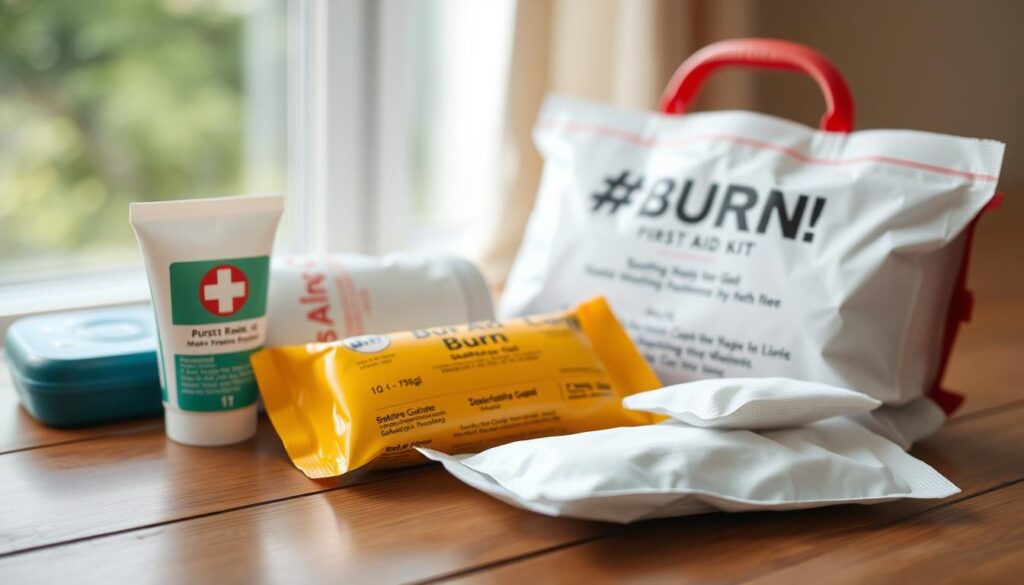Burns are serious injuries that can happen unexpectedly. Quick action is vital to prevent further harm and promote healing1. Knowing the right burn relief techniques can make a big difference2.
Burns come from hot liquids, flames, or electrical gear. They cause tissue damage, ranging from minor surface injuries to severe wounds1. Signs include pain, redness, blisters, and skin changes2.
Fast, proper first aid is key. Cool the burn under cold water for 20 minutes to ease pain and reduce scarring1. It’s crucial to know when to get professional help, especially for kids or sensitive areas2.
Key Takeaways
- Burns can be caused by dry heat, liquids, chemicals, or electricity
- Immediate cooling can reduce burn severity
- Not all burns require the same treatment
- Professional medical advice is crucial for serious burns
- Proper first aid can prevent further skin damage
Understanding Burn Types and Severity Levels
Burns can range from minor surface damages to life-threatening conditions. Recognizing different burn types is vital for proper treatment. Your knowledge can greatly impact medical response and recovery.
https://www.youtube.com/watch?v=Dsvtzwp4nG8
Burn severity depends on depth, size, and injury location. Medical experts classify burns into three main levels.
- First-degree burns: Affect only the outer skin layer, causing redness and mild pain34
- Second-degree burns: Damage outer and underlying skin layers, causing blisters and swelling34
- Third-degree burns: Destroy multiple skin layers, potentially causing permanent tissue damage34
Minor Burns vs Major Burns: Key Differences
Telling minor and major burns apart is crucial for proper treatment. Minor burns affect small areas and top skin layers. Major burns are more extensive and can be life-threatening4.
Common Causes of Skin Burns
Burns can result from various sources. Some groups face higher risks than others.
“Understanding burn risks is the first step in effective burn prevention.” – Burn Safety Expert
When to Seek Emergency Medical Care
Quick medical help is crucial for serious burns. Get emergency care for:
- Burns larger than 2-3 inches
- Burns on sensitive areas like face, hands, or joints
- Third-degree burns of any size
- Signs of shock or extensive tissue damage34
Stay alert and respond quickly to potential burn risks. Your awareness can prevent serious injuries.
Burns First Aid: Immediate Treatment Steps
Quick and proper first aid can make a big difference for skin burns. It helps with healing and prevents further damage. Knowing how to care for burns is key to reducing pain and complications6.
- Cool the burn under running water for 20 minutes
- Remove any tight clothing or jewelry near the burned area
- Apply gentle burn ointments with aloe vera or cocoa butter
- Use sterile burn dressings to cover the wound loosely
Serious burns need immediate medical help. Burns larger than your hand should be checked at a hospital. Chemical and electrical burns need special care and quick treatment6.
Remember: Never use ice, greasy substances, or home remedies on significant burns.
The American Red Cross suggests specific first aid for different burn types7. They stress the importance of proper aftercare to prevent infection and help healing.
| Burn Type | Recommended Action |
|---|---|
| Minor Burns | Cool water, burn ointment, sterile dressing |
| Chemical Burns | Immediate medical attention, identify chemical |
| Electrical Burns | Do not approach, call emergency services |
Your quick response and careful treatment can significantly impact burn recovery.
Conclusion
Burn treatment knowledge is vital for effective healing and preventing complications. Burns are common injuries in various settings. Your approach to burn care can greatly affect recovery outcomes.
Burn prevention should be your top priority. Many people lack proper burn first aid knowledge. Good first aid can ease pain and limit damage8.
Learn about different burn types, from first-degree to third-degree. This helps you know when to seek medical help9.
Professional medical advice is crucial for complex burn cases. Some burns can cause serious issues like infections and scarring9. Stay informed to manage burn injuries effectively.
For detailed guidelines, check out burn care resources. These offer insights into treatment protocols.
Your quick action and knowledge can greatly impact burn treatment. Stay informed and prepared to handle burn emergencies safely.
FAQ
What are the different types of burns?
What are the common causes of burns?
How do I treat a minor burn at home?
When should I seek emergency medical care for a burn?
What should I do for a major burn while waiting for medical help?
How can I prevent burns in the kitchen?
What pain relief can I use for burns?
How do I care for a burn after initial treatment?
Source Links
- Learn first aid for burns | British Red Cross – https://www.redcross.org.uk/first-aid/learn-first-aid/burns
- Burns and scalds – https://www.nhsinform.scot/illnesses-and-conditions/injuries/skin-injuries/burns-and-scalds/
- Burn Severity and Treatment – https://www.templehealth.org/services/burn/how-to-treat-burn/severity
- Burns: MedlinePlus Medical Encyclopedia – https://medlineplus.gov/ency/article/000030.htm
- Burns and Wounds – https://www.hopkinsmedicine.org/health/conditions-and-diseases/burns
- Burns and scalds – Treatment – https://www.nhs.uk/conditions/burns-and-scalds/treatment/
- Burns: Types, Symptoms, and How To Help | Red Cross – https://www.redcross.org/take-a-class/resources/learn-first-aid/burns?srsltid=AfmBOoo0mzMyca8CX_Y9y_hSzDEBkj6c7O6Z1ybYiHh-p8JsPZ6Xob3d
- Burn Basic First Aid: When to Seek Medical Help – https://www.aksharhospitals.com/blog/the-importance-of-burn-first-aid-when-to-seek-medical-help
- First Aid for Burns: Types, Symptoms & Treatment – https://cprcare.com/blog/first-aid-guide-for-burns/
